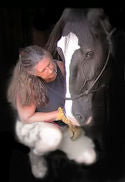More on BARS
OK, to trim or not to trim the bars of the Equine Hoof?
That seems to be a highlighted question nowadays.
I've addressed just what the bars are FOR in a previous blog post:
But let's look at some photographs that will clearly show the extremes from one end of the scale right to the other ...

The photo above shows some pretty extreme bar growth.
One can clearly see here that overgrown bars grow forward over the sole and when doing so, will catch dirt and debris between the sole and the bar material. This can cause lameness. Bar is much stiffer and stronger than sole, if it grows over the sole it will also reduce hoof mechanism by inhibiting the flexion of the sole (expansion and contraction).

This photo shows how the bars have grown over the sole and around the apex of the frog. It is believed that this growth was initiated to protect a weak, thin sole.
At the first sign of discomfort, the horse's hooves should be examined by a competent, knowledgeable and experienced hoofcare practitioner. If the bars are aligned and visible and straight or just slightly curved, there is little to worry about. However, if the bars are overgrown as to be hitting the ground first, before the walls, then the hoof is not going to be healthy and is not being trimmed or maintained properly.
Bars they play a crucial role in the integrity of the foot.
"The hoof wall is thickest in the region of the toe for stiffness. It gradually decreases in thickness as it approaches the heels, and at that point, it inflicts at an acute angle and extends under the foot in a dorsal axial direction to form the bars." -- Dr. Stephen O'Grady
The bars are actually a part of the hoof WALL.
There are several camps of thought on the bars and how they should be trimmed. Given that they do play a strong and supportive role in hoof health and function, it would behoove one to really educate oneself on the proper maintenance of the bars.
One camp believes that bars can become impacted and must be 'dug out'. Another belief is that bars rarely need to be trimmed at all. And then there's the balance in between ... of maintaining the bars as nature would do it on the feral hoof.
The following photo shows the solar view of a barefoot endurance horse that maintains his hooves impeccably through 100's of miles of endurance racing. "Halim" had nice round, tough, strong hooves as you can see:

Notice that you can SEE the bars as extensions of the wall and they do protrude a bit above the sole at the seat of corn.
This hoof --

Is an amazing shot of a wild horse hoof . One can see here that the bars are overlaid over the sole a bit and extend the full length of the frog.
And here below we see a beautifully maintained hoof.

Once again one can readily observe the bars that are strong, healthy and not perfectly flush with the sole but grown a bit beyond.
Let's take a look at some photos where bars have had a bit too much trimming:

The above photo is from my own collection from 2007 (NOT one of my trims or clients' horses but was addressing a concern someone had posted in a forum!!!) where I was pointing out what the ideal form of this hoof would be but ALSO noted the bleeding along the collateral groove (sole) and the bars where someone had attempted to 'dig out' the bars. This is a familiar camp of thought, even today in some circles, but if one really stops and thinks about it, one of the main points to getting healthy barefooted horses is MOVEMENT ... the horse has to MOVE. What horse is going to be able to optimally move on hooves that have been dug out out as depicted above and are bleeding?
FIRST - DO NO HARM!
This is another example from my collection from 2005:

I've blocked out the trimmer's name out of respect for her. However, this hoof shows horrendous invasion into the live bar and wall as is visible from the bleeding.
Again .. FIRST DO NO HARM!
I'm sure you would be horrified to see your horses' hooves trimmed in such a manner.
So there are extremes from both sides ... and then there's BALANCE ... the middleground that the photos of the wild hooves above as well as the endurance horse depict.
Read through the past blog post where I linked above. Find out WHY the horse has bars in its hooves to begin with and then think ... what do you want for YOUR horse?
Oh, and here's a dissection photo to show the bar corium from

You can clearly see how strong the corium of the bars is to validate the NEED for strong bars that are able to withstand the weight of the horse as well as to support the backs of the hooves.
Listen to your gut -- if you are having your horse's hooves trimmed and you feel the bar trimming is getting too invasive speak up! You are your horse's voice. Nature put bars in the horse's foot for a reason. Find the balance between the two extremes.
Building a Supportive Barefoot Community
The team at Scoot Boot believe passionately in the barefoot horse and strive to build a supportive community of barefoot horse lovers.
Find more information about using Scoot Boots here.

Gwen Santagate is the author of "10 Secrets to Healthy Hooves" . For the last 37+ years, she has maintained healthy hooves with natural trimming on thousands of horses and specialized in pathological rehabilitation hoofcare for the last 18 years. She keeps a small herd of her own equines and continues to offer consults for horses in need.
